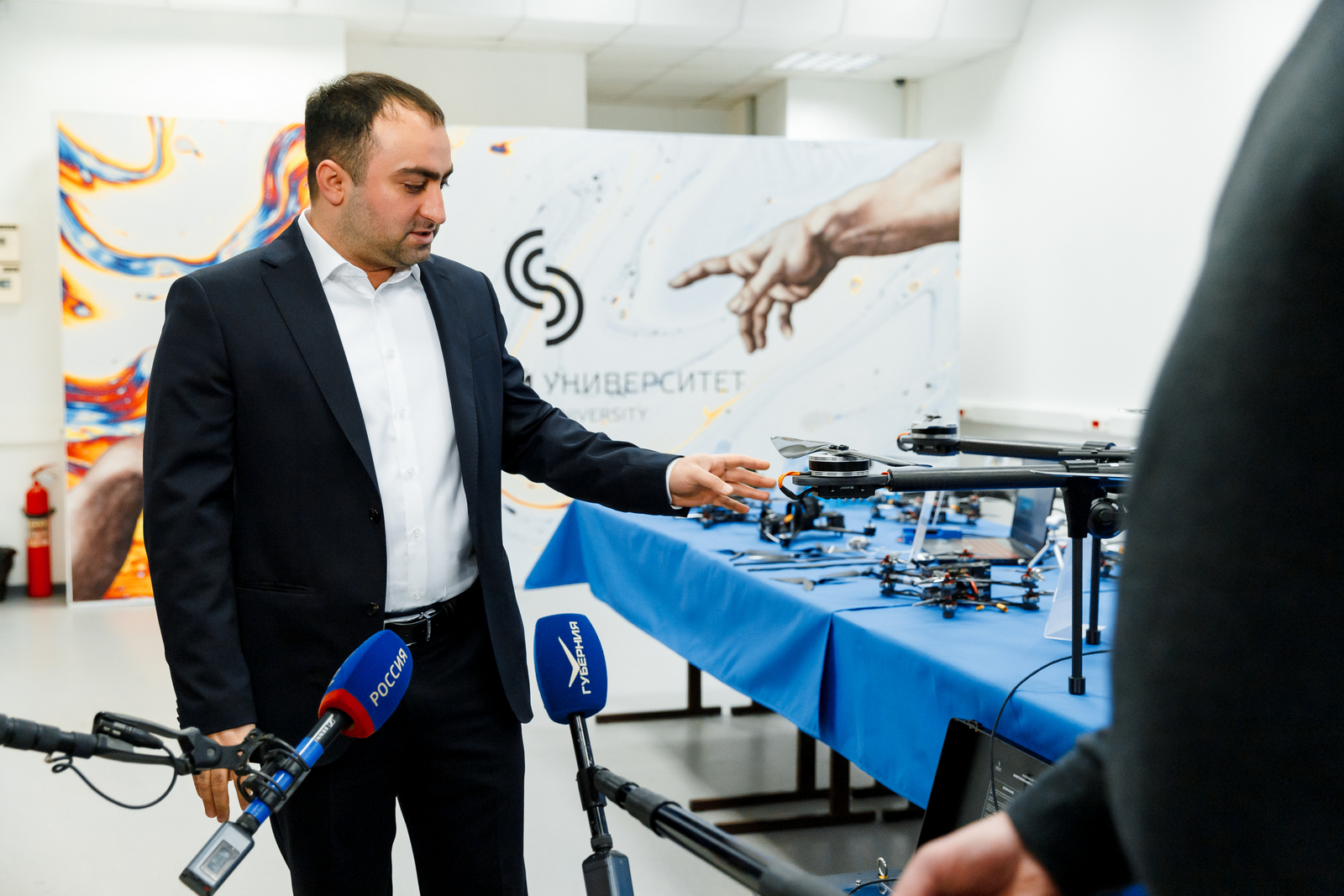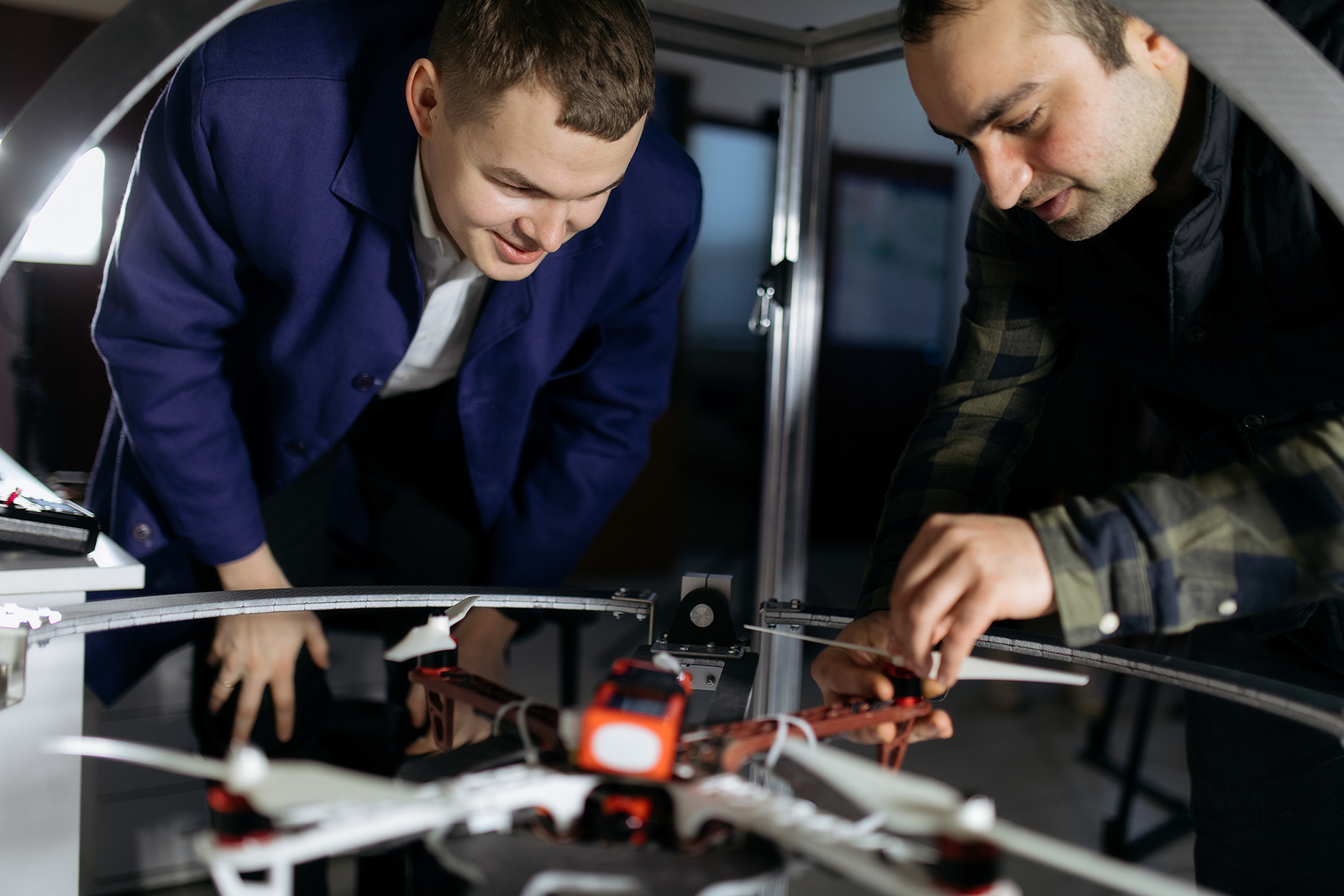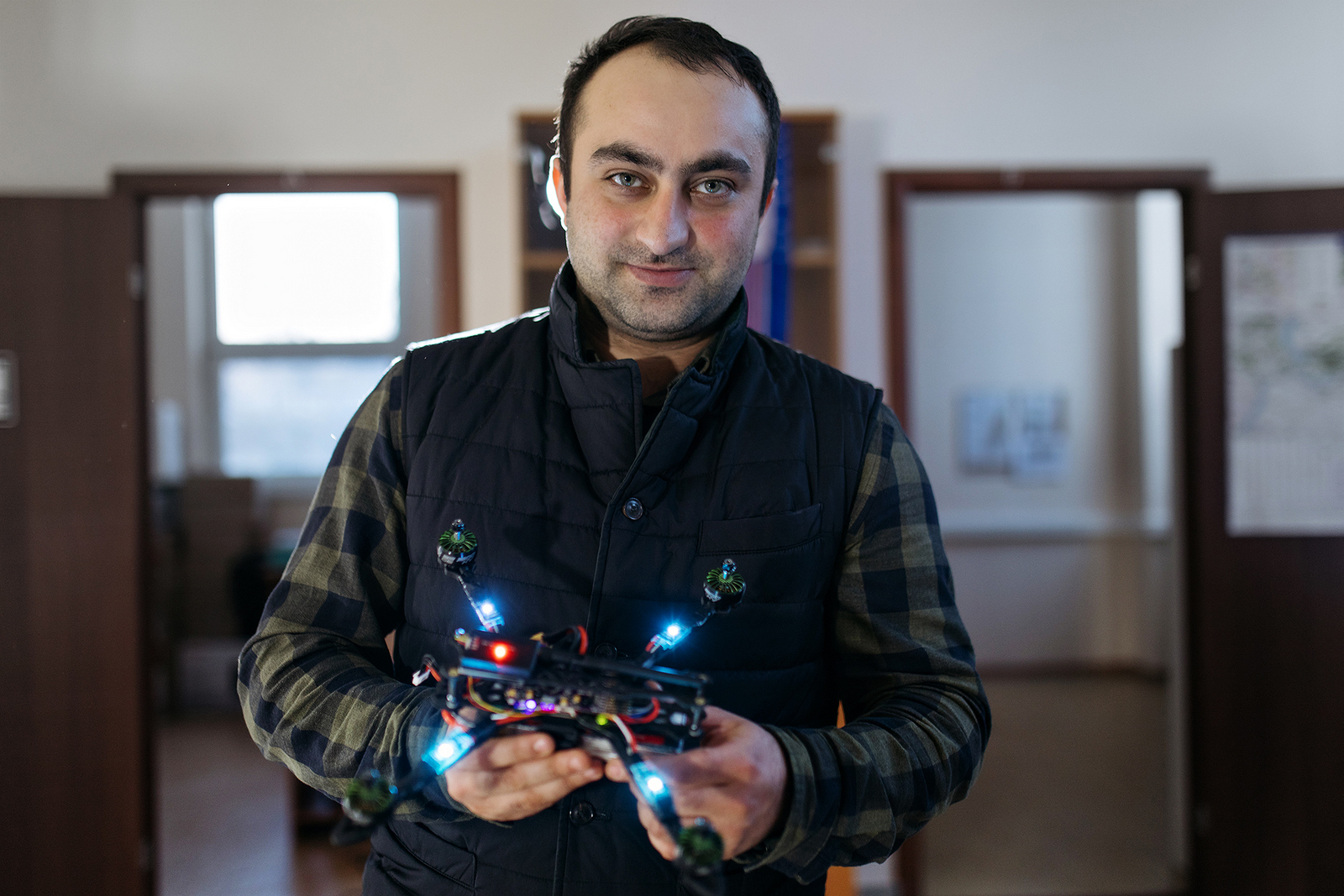The aviation gene is present in everyone
— Unmanned aviation is developing rapidly in the country, and Samara University is in the mainstream. Why do you think that is?
— First, there are all the prerequisites for this: the aviation gene is present, perhaps, in all university graduates. Second, we were among the first in Russia to get involved in this topic. I remember well how in 2013 the first samples of unmanned aerial vehicles (UAVs) began to appear. At that time, there were only five or six organizations in the whole country that used this technique, and even fewer organizations that created and understood this technique. But even then we understood that what other people consider a distant prospect is a matter of the near future.
— When and how did the University Center for Unmanned Systems (CUS) appear?
— The Center for Unmanned Systems was formed in December 2016 as a community of young scientists, students, and graduate students. Up to that point, drones were studied in one way or another in all specialized aviation specialties. The CUS has tried to incorporate all these competencies.
Even before the creation of the CUS, Samara University developed the unmanned aviation industry at all levels of government – local, regional, and federal. The University actively participated in the development of the “roadmap” for the development of UAVs from the beginning of 2016 to 2020, then from 2020 to 2030. The University joined the federal association Aeronet, an association for the development and operation of civilian unmanned aircraft systems (UAS). If in 2016, Aeronet had a very small number of participants, then in 2020 there were dozens, and now there are more than a hundred of them – everyone understood the relevance of the topic. At our University, they believed in this story earlier than anyone else. Evgeny Vladimirovich Shakhmatov, Andrey Bronislavovich Prokofiev, Valery Dmitrievich Elenev, Mikhail Anatolyevich Kovalev and, of course, Vladimir Dmitrievich Bogatyrev helped the CUS move, proving externally that we have these competencies, and simultaneously developing them from the inside.
A new profession in the registry
— When was the turning point in the industry for the Center of Unmanned Systems?
— At the end of 2018, when the line “UAV operator” appeared in the Register of Professions of the country. At that moment, Valery Dmitrievich Elenev supported our initiative to open a program of continuing professional education (CPE) at the University in the area of “Piloting UAVs”, and already in September 2019 we enrolled the freshmen year. The first listeners were inspectors of environmental protection activities of the regional Department of Hunting and Fishing, and then came the Ministry of Environmental Management, Housing and Utilities, law enforcement agencies, road workers, specialists from the Ministry of Agriculture... There are probably no services and departments of the region, whose representatives during this time were not taught piloting skills by us.
In addition, CPE in this area played the role of “buzz marketing” and increased our recognition: we trained listeners from Moscow, Tyumen, Novosibirsk, St. Petersburg, Kazan, and Ulyanovsk. Comparing the quality of education and learning conditions in their cities of presence, they chose us.
— And why do they come to you?
— We are the first in the country to launch continuing education in the field of UAVs at the University. For example, the Moscow Aviation Institute opened this area later. Moreover, in 2020, when COVID was raging, we developed a unique simulator for students – a training complex for UAV pilots that combines virtual reality and a real drone. The development allowed students to remotely connect to the simulator using the Internet at times when there was no opportunity to train in the field, and to practice piloting skills – to see how the drone flies and falls, turns over in the air – using the keyboard on their computers. Since our course consists of theory and practice (you can't teach how to swim in an empty pool!), this development was very useful. Later, we began to use the simulator as a test bed, and this development was actively bought from us. As a result, we assigned the right to develop the invention under a license agreement to our industrial partner Vnukovo and AVIATECH, and, according to the terms of the agreement, the University receives royalties from each sale in the prescribed amount.
— Don’t you mind giving away the rights to the simulator?
— All the results of scientific research should be introduced into the industry and commercialized – this is the policy of the University, patents should bring money, and not hang beautifully in a frame on the wall.
To teach piloting to schoolchildren
— Does the CPE area concern only teaching piloting skills?
— No. Recently, we have opened a new CPE area – it is already connected with the assembly, configuration and programming of UAVs. We also recorded a massive open online course at the University, and it is in great demand: about a thousand people took it in 2023. We also write programs for specific customers, for example, now we are preparing a course for the regional Ministry of Education for school teachers who will learn the basics of UAV assembly and piloting for two months from June 2024.
In 2023, people from 65 regions became students of the CPE program for piloting UAVs. Thus, we are currently training UAV pilots, UAV assemblers and teachers of educational institutions who will teach children the basics of UAV assembly and piloting.
The pool of customers is expanding
— How has the pool of your partners changed since 2018 and, accordingly, your tasks?
— For example, we are currently working with Russian Railways on three programs, in which the state and integrity of the land under sleepers, soil, rockfall areas, especially where there are mountains (for example, the Urals), as well as areas with bridges and crossings, are monitored using drones.
We help specialists in the field of housing and utilities and power engineers to check the condition of roofs, because if damage is formed at the top, heat goes out from there, while leaks can be detected using a thermal imager mounted on a UAV.
We help specialists from the Department of Ecology to detect the state of atmospheric air using a gas analyzer, also created at the University and installed on a UAV. If the classical services measure the composition of the air no higher than 15 meters, then we rise to a higher level, where, as a rule, it is possible to track emissions in the air.
— Are there any industry partners among your customers?
— Of course, we not only teach piloting – in the interests of customers, we develop UAS control systems, individual nodes (modules) for autopilots, regulators, electronic stuffing, and much more. Our partners include the manufacturer of unmanned aircraft systems Finco LLC from Izhevsk, the city where 4 % of all drones in the world are produced! This is also the Radar MMS plant from Saint Petersburg, one of the leaders in the field of creating radio-electronic systems, which is also engaged in UAS. We also cooperate with the Samara company Pegas Agro, which produces agricultural machinery.
Codes Testing
— It turns out that the attention of industrial partners to you is growing.
— Just one example. In 2023, we set a record: we manufactured more than 800 UAVs at the University. However, I would say that there has been many times more attention to the industry itself. The topic includes science, business, and education. In this sense, the Samara Region is in a winning position – companies with multimillion-dollar investments are coming to the region. A large investor appeared – the “Transport of the Future” company, and a cluster for unmanned aircraft was formed in the province, a plant for the production of UAVs and components is being built. On the basis of the Aviakor plant, active production of UAV parts is underway, companies such as DELTATECH, which produces small-sized UAVs with secure communication systems, AVTOKOM, specializing in the creation of a component base and a whole range of UAVs, are developing – cooperation agreements have been signed with them.
— And what are you doing for the “Transport of the Future”?
— We make test benches for them, UAV control systems, participate in artificial intelligence projects, namely, we test the codes and programs that the University's Institute of Artificial Intelligence is developing for the “Transport of the Future” on real hardware and give them feedback on how UAVs behave in flight.
— What kind of drones are you testing?
— Now we are talking about creating a “Transport of the Future” line of UAVs, which includes agricultural drones for spraying fertilizers, as well as drones for logistics transportation.
— And what are you doing for AVTOKOM?
— AVTOKOM is developing a new area for itself – a component base for drones, although they traditionally produce it for the domestic automotive industry. We are manufacturing a prototype (working prototype) of UAV electronic components for AVTOKOM with all related design and technological documentation so that it can be immediately transferred to the chief engineer at the plant and put into production.
“Green light” for the development of UAVs
— In 2023, everyone talks about the development of drones in the region. Why?
— 2023 has become a defining year for the entire industry and especially for our region. In 2023, a new National Project appeared in the country – “Unmanned aircraft systems”, which prescribes the development of UAVs until 2030. There are five federal programs within the National Project: for the creation of UAVs, for the development of promising types of aircraft, for training personnel for the industry, and for fundamental research in this area. As you can see, our University has everything for the implementation of this national project – artificial intelligence, electronics, programming, mathematics, physics, chemistry, and many other sciences. We are proud that we have applied competencies based on a strong fundamental base and in demand by the country.
It was in 2023 in a record short time (in just eight months) that the Samara Region has received the status of a region with an experimental legal regime (ELR) for testing UAS. The status was influenced by the presence of a serious investor, competence and potential in the field of aviation, an advantageous geographical location and, of course, the development of new markets related to drones.
— What does this status give to the region?
— New technologies, products, and goods in the field of UAS are being created, but the mechanisms for their use have not yet been regulated by law. A striking example: a drone can deliver medicines (and this is a product of high urgency) from one point to another in three minutes, without traffic jams and couriers. But UAVs cannot fly freely now, you need to request permission three days before the flight. In order to work out these and other regulations in the legal and technical field, ELRs are being created in certain regions.
— At what altitude can such drones operate?
— Up to 150 meters. It is precisely within the framework of the ELR that it is necessary to determine a safe corridor for drone flights for people. This requires a “green light”, and the region has it. It is planned to start such tests on agricultural lands, as well as in Togliatti, Zhiguli Valley and partially in Samara.
In the same year, 2023, the Samara Region won a competition to create the first regional research and production center (RPC) for civilian unmanned aircraft systems. As part of the work of this RPC, a test certification center for UAVs will be opened near Togliatti. Right now, we are engaged in training personnel for RPCs, carrying out research and development work, developing electronics, and preparing test benches.
So, in all areas of development of unmanned aviation, the Samara Region is in the limelight.
Source: firstsamara.ru
 RU
RU  EN
EN  CN
CN  ES
ES 



